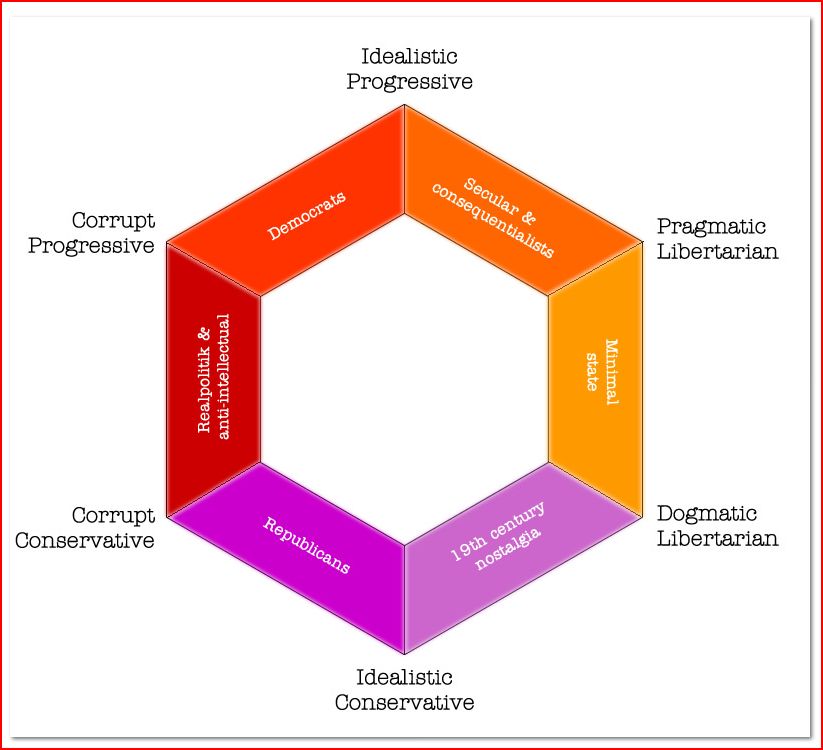 Sumner expands the standard Libertarian square (socially liberal or conservative vs. fiscally liberal or conservative) into an interesting hexagon with two styles each (idealistic or pragmatic) of progressive, libertarian, and conservative based on three sets of ethics: utilitarian, rights, or selfish. Each pair of adjacent nodes shares something in common, such as 19th century nostalgia or anti-intellectualism.
Sumner expands the standard Libertarian square (socially liberal or conservative vs. fiscally liberal or conservative) into an interesting hexagon with two styles each (idealistic or pragmatic) of progressive, libertarian, and conservative based on three sets of ethics: utilitarian, rights, or selfish. Each pair of adjacent nodes shares something in common, such as 19th century nostalgia or anti-intellectualism.BTW, perhaps I should explain what I mean by “corrupt.” I don’t mean politicians taking bribes that violate existing laws. I mean Republicans who support various special interest groups like doctors and seniors (Medicare), farmers, energy producers, car dealers, bankers, and the rich, even if it goes against their supposed “small government” ideology. And the same would be true about Democrats who support various special interest groups like teachers unions, trial lawyers, government workers, etc, for non-utilitarian/non-egalitarian reasons.The purpose is less to identify into which of these nodes an individual fits and more to identify why there are still a number of low-hanging political fruits that aren't part of any discussion. The problem is that the real politic groups all agree (the status quo is good) and all the intellectuals agree (the status quo is terrible) and because there is no intragroup conflict, the media doesn't report on the issue. It is to identify political alliances rather than as a personality test.
At thee risk of being more complicated, I think it would be better still to make a nonagon with the three value systems and three ideologies in groups. As is, Sumner's diagram seems to ignore one third of the categories (e.g. selfish libertarians who want no government interference because they assume they would be the strong who survived and would get a yet bigger share of the pie rather than because they believe minimal government produces the greatest economic growth for future generations of the poor).
 Klein, on the other hand, believes it is partly lobbying coalitions and partly blindness that create the government process we see: "The budget ends up like the yard of a man who owns only a lawnmower: The grass is trim, but the trees are overgrown and the ivy is everywhere and the gazebo is falling apart. Yet we keep mowing, because that’s what we feel able to do." Yglesias (unsurprisingly) sees a more sinister coalition of conservatives who want to cut government spending so that it is easier for corporations to break the now-unenforced laws and regulations. (As a bonus, here is a discussion and map of states where more than half of their population is in a single metro area - city-state creation time, anyone?)
Klein, on the other hand, believes it is partly lobbying coalitions and partly blindness that create the government process we see: "The budget ends up like the yard of a man who owns only a lawnmower: The grass is trim, but the trees are overgrown and the ivy is everywhere and the gazebo is falling apart. Yet we keep mowing, because that’s what we feel able to do." Yglesias (unsurprisingly) sees a more sinister coalition of conservatives who want to cut government spending so that it is easier for corporations to break the now-unenforced laws and regulations. (As a bonus, here is a discussion and map of states where more than half of their population is in a single metro area - city-state creation time, anyone?)As fun as these thoughts are to play with, Marron provides more pragmatic suggestions for tax reform, such as: "the first step in any income tax reform should be to broaden the tax base by reducing or eliminating tax preferences.... Policymakers can use the resulting revenue – potentially hundreds of billions of dollars each year – to lower tax rates, reduce future deficits, or both."
No comments:
Post a Comment